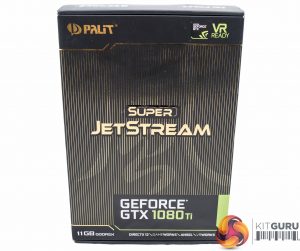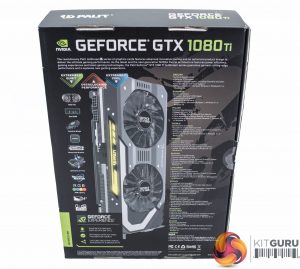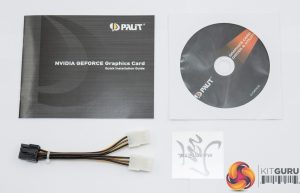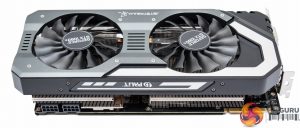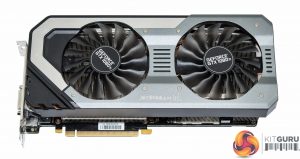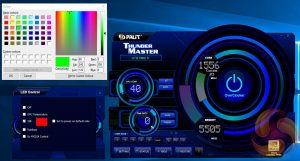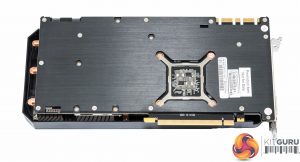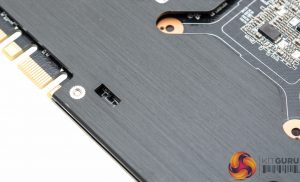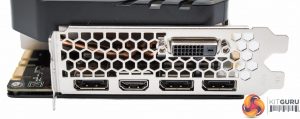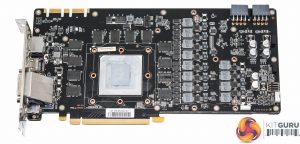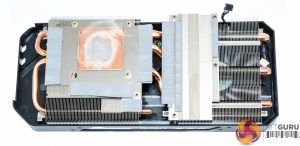Packaging with the Palit GTX 1080 Ti Super JetStream is elaborate and unique. Few graphics card vendors have such a distinctive style as Palit.
The accessory bundle is basic – a user's manual, driver & utility CD and a case sticker. The power adapter, which takes two 6 pins and creates an 8 pin, most probably shouldn't be used with a graphics card of this calibre.
Palit's Super JetStream is tastefully designed reflecting consumer preferences of the day. The overall design uses a subtle blend of black, grey and silver even if it's a little boxy in shape. The majority of the shroud is crafted from metal, rather than plastic – which gives a premium feel to the product.
Palit uses dual 10cm fans, rather than opting for a triple fan setup, which has some benefits in that the graphics card doesn't end up being as long as some triple fan solutions. Furthermore, dual fan graphics cards tend to use two large 10cm fans versus three 80 or 90mm fans for triple fan graphics cards, and as a general rule of thumb the dual-fan setup should be quieter because larger fans can spin slower for the equivalent airflow of a smaller fan.
The Palit card measures in at 28.5cm long (30cm including the rear I/O) and 13cm high (15cm including the rear I/O) and weighs 1344g.
The Palit logo and corresponding white surface area on the top of the card encloses the RGB system. Palit makes this controllable through its in-house software utility called ThunderMaster.
The ThunderMaster utility is reasonably easy to use for controlling the LEDs – there are five key options to choose from which include ‘still' colours, e.g. a single fixed colour, a colour that varies by GPU temperature or a rainbow effect. It's not the most advanced implementation for controlling RGB LEDs since it lacks a wide variety of lighting modes, neither do we necessarily like the ThunderMaster software for overclocking either, but it gets the job done.
Palit implements a full cover metal backplate with a nice premium finish to it. Hidden within that backplate is the dual BIOS switch that toggles between a “standard mode” (Position 2) and “OC mode” (Position 1) UEFI. By default the graphics card will ship with the faster OC mode enabled to give the end user the best experience.
Palit provides vBIOS downloads on the product page so it is possible to reflash either of the BIOS chips as the user desires, though most probably any non-standard vBIOS modifications void the standard 2 year warranty.
The rear I/O offers three DisplayPort 1.4, one HDMI 2.0b and dual-link DVI ports. The overall profile of the card exceeds two slots, it's somewhere between 2.5 and 3 slots in thickness, so for all intents and purposes this is a triple-slot card.
The PCB houses an 12 phase VRM for the GPU core with an additional two phases for the GPU memory, for a total of 14 phases. This is on par with many rival solutions – for instance Gigabyte's Aorus model used 12+2 phases. It is also an improvement over the default 7 phases on the Founder's Edition card and considerably more than the average user would ever need, even when overclocking quite heavily.
The cooling solution is something of a behemoth pushing the card into triple-slot territory. There are five heat pipes ensnared within, three 8mm and two 6mm, all of which feed into a very dense aluminium heatsink array that is cooled by dual 10cm fans.
All the main PCB components, the memory chips and main power components are allocated thermal pads to help with heat dissipation. The main bank of VRM components is also connected to the backplate via another thermal pad, for further heat dissipation capabilities.
Be sure to check out our sponsors store EKWB here
 KitGuru KitGuru.net – Tech News | Hardware News | Hardware Reviews | IOS | Mobile | Gaming | Graphics Cards
KitGuru KitGuru.net – Tech News | Hardware News | Hardware Reviews | IOS | Mobile | Gaming | Graphics Cards


